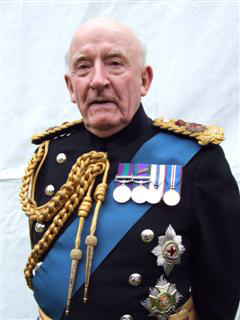
Field Marshal Peter Anthony Inge, Baron Inge, was a senior British Army officer. He was the Chief of the General Staff, the professional head of the British Army, from 1992 to 1994 and then served as Chief of the Defence Staff before retiring in 1997. Early in his military career he saw action during the Malayan Emergency and Operation Banner in Northern Ireland, and later in his career he provided advice to the British Government during the Bosnian War.

General Sir Peter John Cosgrove, is an Australian retired senior Army officer who served as the 26th governor-general of Australia, in office from 2014 to 2019.
Commandant is a title often given to the officer in charge of a military training establishment or academy. This usage is common in English-speaking nations. In some countries it may be a military or police rank. It is also often used to refer to the commander of a military prison or prison camp.
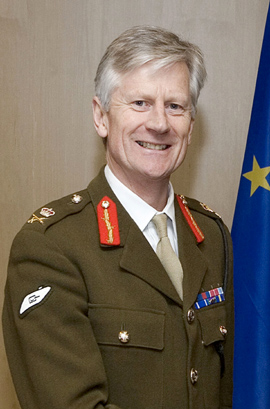
Lieutenant General Arundell David Leakey, is a former British Army officer. He was Director General of the European Union Military Staff in the Council of the European Union, Brussels. In 2010 he was appointed Gentleman Usher of the Black Rod, a role he held until February 2018.

Lieutenant General Sir John Northcott was an Australian Army general who served as Chief of the General Staff during the Second World War, and commanded the British Commonwealth Occupation Force in the Occupation of Japan. He was the first Australian-born Governor of New South Wales.
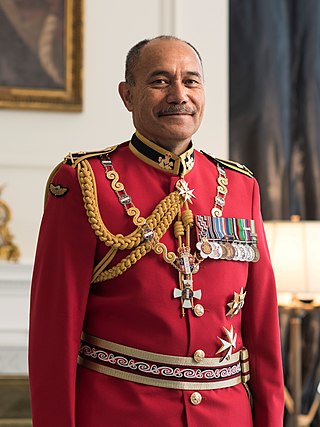
Lieutenant General Sir Jeremiah Mateparae is a former New Zealand soldier who served as the 20th governor-general of New Zealand between 2011 and 2016, the second Māori person to hold the office, after Sir Paul Reeves. A former officer in the New Zealand Army, he was the Chief of the Defence Force from 2006 to 2011, and then served as the director of the New Zealand Government Communications Security Bureau for five months in 2011. Following his term as governor-general, Mateparae was the high commissioner of New Zealand to the United Kingdom between 2017 and 2020.
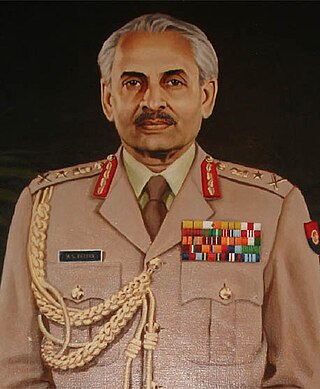
General Arunkumar Shridhar VaidyaPVSM, MVC & Bar, AVSM, ADC was an Indian Army general. He served as the 12th Chief of the Army Staff from 1983 to 1986. Following his retirement, he was assassinated by Harjinder Singh Jinda and Sukhdev Singh Sukha in August 1986, for his role in Operation Blue Star in 1984.

General Francis Richard Dannatt, Baron Dannatt, is a retired senior British Army officer and member of the House of Lords. He was Chief of the General Staff from 2006 to 2009.
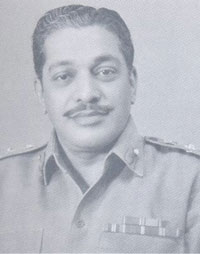
General Deshamanya Don Sepala Attygalle, was a Sri Lankan army officer, civil servant and diplomat. The longest serving Commander of the Sri Lankan Army (1967–1977), he went on to serve as the Permanent secretary to the Ministry of Defence and Sri Lankan High Commissioner to the United Kingdom.

General David John Hurley, is an Australian former senior officer in the Australian Army who served as the 27th governor-general of Australia from 2019 to 2024. He was previously the 38th governor of New South Wales from 2014 to 2019.
General Sir David William Fraser, was a senior British Army officer who served as Commandant of the Royal College of Defence Studies from 1978 until his retirement from military service in 1980. He was also a prolific author, publishing over 20 books mostly focused on the history of the Second World War.

Lieutenant General Henry John Coates, was a senior officer in the Australian Army who served as Chief of the General Staff from 1990 to 1992. After retiring from the army, he became an author and a visiting fellow at the Australian Defence Force Academy branch of the University of New South Wales, pursuing aspects of Australia's military history.

Lieutenant General John Graham Caligari, is a retired senior officer of the Australian Army. He served as Chief Capability Development Group from October 2014 until his retirement in August 2015.

Major General Sir Keith Lindsay Stewart, was a professional soldier in the New Zealand Military Forces. He served during the First and Second World Wars and was Chief of the General Staff of the New Zealand Military Forces from 1949 to 1952.

Lieutenant General Timothy James Keating is a former New Zealand Army officer and Chief of the New Zealand Defence Force. He was appointed Chief of Defence Force in 2014, immediately following his tenure as Vice Chief of Defence Force. He served as Chief of Army from 2011 to 2012.

Chief of Army (CA) is the effective commander of the New Zealand Army, responsible to the Chief of Defence Force (CDF) for raising, training and sustaining those forces necessary to meet agreed government outputs. The CA acts as principal advisor to the CDF on Army matters, though for operations the Army's combat units fall under the command of the Land Component Commander, Joint Forces New Zealand. The rank associated with the position is major general, and CAs are generally appointed on a three-year term.
Major General Louis Joseph Gardiner, was a New Zealand military officer. He served as Chief of Army from 2006 to 2009, and later was the chief executive of Crimestoppers New Zealand.
The 1956 New Year Honours in New Zealand were appointments by Elizabeth II on the advice of the New Zealand government to various orders and honours to reward and highlight good works by New Zealanders. The awards celebrated the passing of 1955 and the beginning of 1956, and were announced on 2 January 1956.
Lieutenant General Anthony Leonard Birks, was a senior officer in the New Zealand Army. He served as Chief of the General Staff, the professional head of the New Zealand Army, from 1992 to 1995, and in New Zealand's most senior military post as Chief of Defence Force from 1995 until his retirement in 1999.

Lieutenant General Simon Andrew Stuart, is a senior officer of the Australian Army who has served as the Chief of Army since July 2022. He was commissioned into the Royal Australian Infantry Corps from the Royal Military College, Duntroon in 1990. He has commanded the 8th/9th Battalion, Royal Australian Regiment (2008–10), Joint Task Force 631 (2010) and Combined Team Uruzgan (2012–13), and deployed to East Timor as part of Operations Warden, Tanager and Astute and to Afghanistan and the Sinai Peninsula. He was Force Commander, Multinational Force and Observers in the Sinai from 2017 to 2019, and Head Land Capability from 2020 to 2022. He succeeded Lieutenant General Rick Burr as Chief of Army on 2 July 2022.














